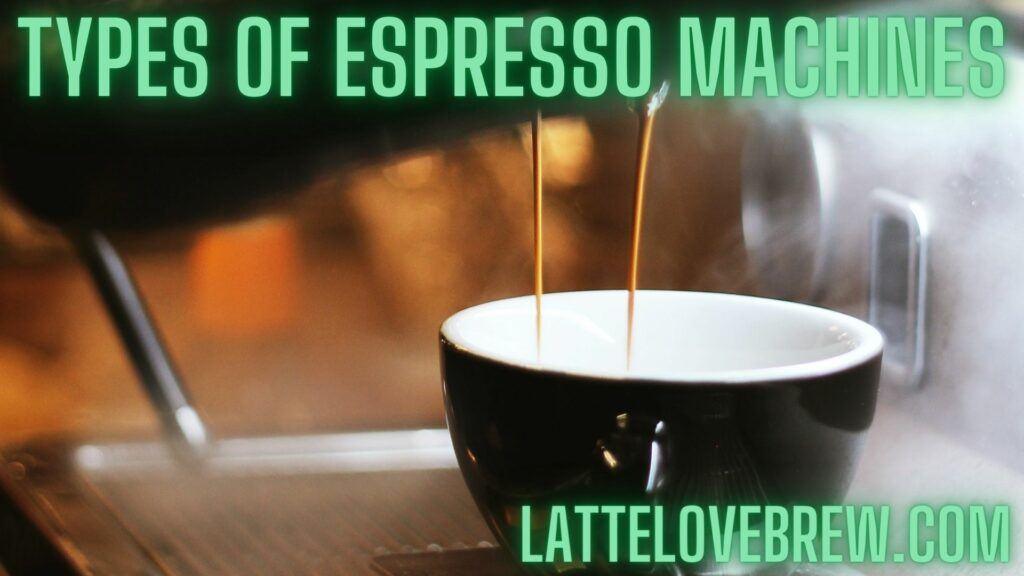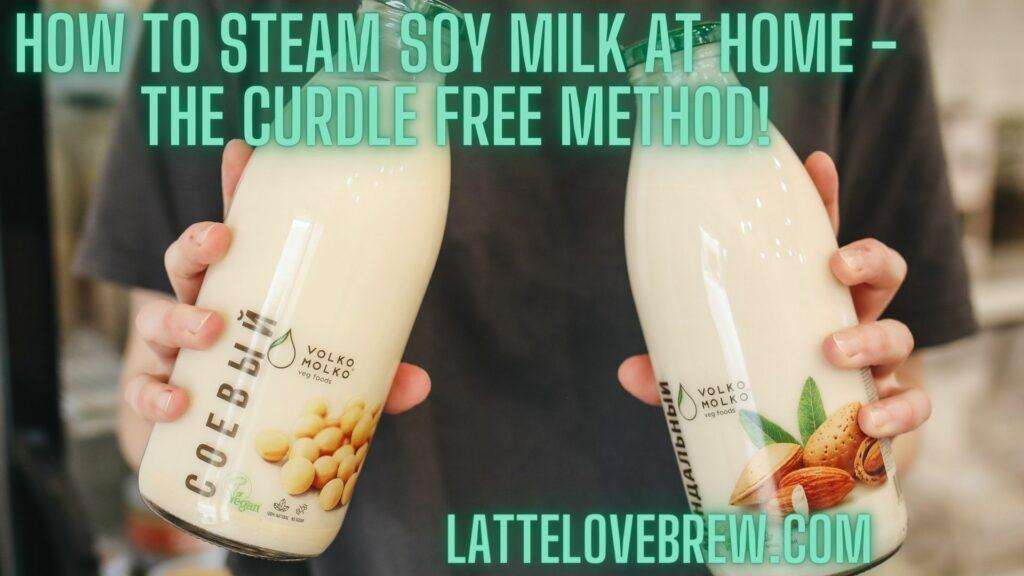Last updated on May 20th, 2024 at 11:58
There is a wide range of different types of espresso machines, from commercial to home espresso machines to complex variations including double boiler, single boiler, steam, lever operated and so on.
This article is designed and written to help you navigate the minefield and understand the differences between them and better decide which is best for you and will get you pulling that perfect shot.
Keep reading as we talk about and detail the different types of espresso machines.
What Is An Espresso Machine?
Table Of Contents
- 1 What Is An Espresso Machine?
- 2 Types Of Commercial Espresso Machines And The Different Types Of Home Espresso Machines
- 3 Manual Espresso Machines
- 4 How Do Espresso Machines Work?
- 5 What Coffee Drinks Can You Make With An Espresso Machine?
- 6 Frequently Asked Questions About Types Of Espresso Machines
- 6.1 What’s The Difference Between An Espresso Machine And A Coffee Machine?
- 6.2 What Are The 2 Main Machines Used When Making Espresso Coffee?
- 6.3 What Is The Difference Between Steam And Pump Espresso Machines?
- 6.4 Does An Expensive Espresso Machine Make A Difference?
- 6.5 What Machine Do Baristas Use?
- 6.6 Is It Worth It To Buy A Home Espresso Machine?
- 6.7 Does It Matter What Espresso Machine You Use?
- 6.8 Which Espresso Machine Is Used By Starbucks?
- 7 Frappé-Ing It All Up – Types Of Espresso Machines
As clear as it can be, an espresso machine is a coffee machine that brews 2/3 of an ounce to two ounces (20ml to 60ml) shots of highly focused and concentrated coffee with hot water of 92C – 96C (195F to 205F) through a puck of coffee ground to an 80 micron to 100 micron particle size.
The result is a thick, focused and intense coffee with a rich crema on top, the humble espresso.
The espresso machine dates back to the early 1900s and has changed dramatically from the original built by Luigi Bezzara.
Despite the differences in modern machines, there are many common elements such as portafilter, steam wand, and water reservoir.
They can be piston driven, air pump driven, steam driven and regular pump driven. And can be automatic, semi-automatic or super-automatic.
An espresso can brew a wide range of espresso drinks such as a ristretto, doppio, latte’s, cortados, flat whites and all kinds of coffee drinks both with and without milk.

Read: Manual coffee maker
Types Of Commercial Espresso Machines And The Different Types Of Home Espresso Machines
There are various different types of home espresso machines and commercial espresso machines which can be as different as you can imagine.
Let’s get this rolling with Semi-Automatic Espresso Machines, perhaps the type you are more familiar with.

Read: Pump driven espresso machine
Semi-Automatic Espresso Machines
This is most likely what you see or picture in your mind when you are thinking of a professional espresso machine that your local run-of-the-mill coffee shop has. Semi-automatic machines drive water through the group head and then through your grounds and the portafilter by means of an automated system.
The grinding of your beans, tamping and the control of extraction time are left to you, the home barista, to take responsibility for.
This is good as these are variables that you can control, and, in my opinion, some human control is required to pull the perfect shot and get a degree of variability in strength and flavor. The water pressure and the water temperature are regulated and constant, which is great as adjusting these for every shot can be rather annoying.
Due to you initially setting the water pressure and the temperature yourself when you first get the machine, it can be argued that there is a degree of complete control of these variables.
Automatic Espresso Machines
Automatic espresso machines are very similar to the above-mentioned semi-automatic machines with the difference being the fully automatic machine measures an exact volume in the shots of espresso that you pull with no need for you to halt the process.
This type of machine is one you will see in more high-end coffee shops. You can tell if the coffee shop you visit has an automatic or semi-automatic by observing the barista. If he or she has no need to stop the machine, it is a fully automatic machine that is being used.

Super Automatic Espresso Machines
Super Automatic espresso machines are the kind of machines that do it all at the push of a button. You will see super automatic espresso machines in gourmet coffee shops like Starbucks.
This type of espresso machine is one that does everything, absolutely everything! They grind, measure, tamp, and viola you get a perfect, consistent shot every single time.
Even your milk is frothed for you, when milk is required.

Manual Espresso Machines
A manual espresso machine is the exclusive love of coffee purists, perfectionists and seldom used by others.
They come in two distinct types, pump and lever.
Let’s talk about those types of espresso machines.
Lever Espresso Machines
Lever based espresso machines are also known as piston driven espresso machines. The design is simple. They are designed with a piston that is used to create water pressure of 9 bar (130 PSI) or more to produce an espresso shot.
The machine is operated manually by means of pulling a lever. This type of coffee machine was manufactured by La Pavoni, and will produce, when you get the hang of it, high quality shots of espresso.
Some hard core enthusiasts will even insist the shots produced by a lever based manual espresso are the best and of the highest quality possible.
They are not 100% manual as you still need to plug it for the boiler to produce the hot water that you need. A coffee purist friend told me they can take a while, a dozen or so shots to get your manual machine set up perfectly to get that excellent shot of espresso.
You can tailor the pressure and make adjustments to the machine to get it exactly as you love it.
If you are a serious coffee lover or coffee shop owner, having one of these really makes your set-up stand out, and they are very eye-catching and often invite the “what is that for?” question.
Don’t forget to get your hands on a quality tamp as a tamp is rarely attached to this type of machine. Coffee tampers are cheap enough and inexpensive to find.

Why Use A Manual Espresso Machine?
Firstly, they give you full control of all aspects of pulling a shot, making the end product absolutely perfect. Secondly, they are also considerably cheaper than an automatic machine.
I’ll also add that they are much more portable, meaning you can take it with you on easily. Compare that to a clunky large semi-automatic or fully automatic machine. You’ll never be without your beloved espresso machine.
If you own a coffee shop, like I do, you can treat your special clients to an at the table experience with the use of a trolley and a battery power set up to ensure you have power for your hot water.
Pump Based Manual Espresso Machines.
For clarity, a pump driven machine can be an automatic or manual machine depending on the pump being electric or manually operated.
Electric pump machines are either rotary or vibration pumps. A manual pump requires the user to pump on a lever several times to build up enough pressure for the shot to be pulled.
This type is older and less consistent in the pressure than a manual lever piston based system and needs more maintenance. They are also more difficult to find these days.
How Do Espresso Machines Work?
So, let’s dig deeper into how the various espresso machines work, let’s get below the hood, let’s get started with…
Steam Powered Espresso Machines
Invented in 1884 by Italian Angelo Moriondo, literally the inventor of the steam-powered espresso machine and the first coffee machine to use pressure to brew a cup of coffee.
These electric steam-driven espresso machines are still used all over the world today, although rare. They lack complexity and their functionality is very simple.
In a sealed airtight water tank, water is taken to the boiling point and steam is produced, which produces the pressure required to force the water into a reservoir and finally into the coffee in a way that is not too dissimilar to a moka pot.
The main drawback is the lack of pressure with only 1 bar to 1.5 bar of pressure, which is well short of the 9 bar of pressure required to produce a great shot.

Types Of Steam Espresso Machines
There are different types of steam espresso machines. As I mentioned, the good old and trusted moka pot is one of them. The water heats up from the bottom chamber and up and over the coffee grounds and into the upper chamber, the result of which is a strong and almost espresso-like coffee.
It is not quite an espresso, but most certainly, what is produced is more than good enough for a homemade latte.
There is the new steam espresso machine which looks very much like a mini version of a drip coffee machine but has the advantage of making a much better quality cup of coffee. It is still not much better than the original steam powered espresso machine due to the inherent problem of a lack of pressure being produced.
Still, despite their faults, you will be able to make a reasonably good coffee for using in your latte’s and cortados but not a straight-up espresso shot.
Pump Driven Espresso Machines
Espresso machines got better in the 1960s with the advent of pump-driven espresso machines. These function via an electric pump that drives preheated water to a brewing chamber and then onto and through a bed of finely ground coffee grounds via the grouphead and into your coffee cup via the portafilter.
Thanks to the electric pump it is much easier to achieve a higher water pressure and to achieve this on a consistent basis.
The result of this is a predictable quality of shot and repeatable time and time again.
Lever Driven Espresso Machines
We touched on this earlier, let’s go into more detail.
A lever-driven espresso machine requires the barista to have the physical strength to pull a shot. Thankfully, not a lot of strength is required.
Modern lever machines fall into two main categories: spring-loaded and manual.
A manual espresso machine is easily recognizable due to the horizontal position of the lever when it is not in use. When the lever is pushed upwards, the brewing chamber opens up and the hot water saturates your grounds, giving you, the barista, full control over how long the hot water stays in the pre-infusion stage for. You can also control the flow rate and the pressure when you pull down the lever.
With spring-driven manual espresso machines, the lever is vertical when the spring is in its relaxed position. When you pull down on the lever the piston moves up and opens the chamber for the hot water to flow into.
As the tension is released from the spring, the piston pushes the hot water down and extracts your shot of espresso.
Manual espresso machines allow you to have a longer pre-infusion if your beans require more time to extract the flavor and a distinct pressure, the result of which is an espresso that is perfect and allows for more creativity on the part of the barista.
Lever machines are a lot slower at producing a shot of espresso and are not ideal when you need to make a lot of them and quickly. They are not really ideal for use in a coffee shop, unless you plan on having a few of them or as an option alongside an automatic machine.
One way of looking at this kind of machine is to think of them as training tools that will train you and help you to understand the variables associated with brewing a great shot of espresso and how they affect your shot.
What Coffee Drinks Can You Make With An Espresso Machine?
There is no limitation to what coffee drinks you can make with an espresso machine other than a French press, drip coffee, pour over coffee, siphon coffee as these are all different brewing techniques.
All the espresso-based drinks like a ristretto, doppio, an espresso shot itself, a cortado, Americano, Affogato, latte, flat white and many others are all possible with an espresso machine.
Basically, all the main coffee drinks can be made and enjoyed.
Frequently Asked Questions About Types Of Espresso Machines
What’s The Difference Between An Espresso Machine And A Coffee Machine?
An espresso machine uses pressurized hot water which is forced through a bed of finely ground coffee in a matter of seconds, 25 seconds with a variance of plus or minus 5 seconds. Regular coffee makers like a drip coffee work using a much larger grind size and gravity to draw the water through the filter.
Single serve coffee makers like a Nespresso and a Keurig pass a jet of water through the coffee pod or K-Cups which have a mini filter inside them, making them more like a complex filter coffee. A Nespresso uses centrifugal force and spins the pod at a high speed.
What Are The 2 Main Machines Used When Making Espresso Coffee?
Multi boiler and heat exchange are the two types of commercial espresso machines that are used.
What Is The Difference Between Steam And Pump Espresso Machines?
A steam espresso machine produces at best espresso like coffee and lacks the required pressure to produce a shot with a rich thick crema on top. A pump espresso machine is what you’ll see at your local coffee shop and produces a high-quality rich tasting shot of espresso with the thick crema on top.
One works with the use of steam to create pressure while the other uses a pump.
Does An Expensive Espresso Machine Make A Difference?
Yes, an expensive espresso machine is worth the extra pennies and does make a difference, a big difference in terms of quality off the final product, and you will get more features like pre-wetting, pressure monitors, temperature control and more.
They are also made of higher quality materials and will last you longer. That significantly better cup of coffee will be the result of spending that extra money.
What Machine Do Baristas Use?
The type of machine that baristas use are pump-driven espresso machines. These are, by far, the most common type of espresso machine that is used by coffee shops. They function by sending pressurized hot water through the ground coffee beans by using a pump. The pump maintains a consistent preset pressure of 9 Bars (130 PSI). and use an electronic control system to control the temperature and the pressure.
This type of machine ensures that you get a consistent espresso every time you use it.
Is It Worth It To Buy A Home Espresso Machine?
Yes, a good quality home espresso machine is worth the investment; in fact, it is more than worth it. You will get quality shop coffee at home and really start to get the best out of your premium quality single origin coffee beans.
Also, a neat little side effect, you’ll go to Starbucks and other coffee shops less, and you’ll notice that your own coffee is much better, and thus you will save money. I said it is an investment, you will end up saving way more than you would normally spend on coffee than what the machine will cost you.
Does It Matter What Espresso Machine You Use?
Yes, different machines produce different results. A dual boiler pump-driven espresso machine is the best type to look for. Blind taste tests with the same beans making the same drink have proven that this makes better coffee.
Which Espresso Machine Is Used By Starbucks?
The espresso machine used by Starbucks costs a whopping US$36,000 at the current price. It’s a Mastrena and is made exclusively for Starbucks. It’s a fully automatic machine where all you need to do is to press a button and that is it, the coffee comes out.
They focus on machines that streamline the brewing process for maximum quality and efficiency.
Frappé-Ing It All Up – Types Of Espresso Machines
There are many different types of espresso machines that will get you making great espresso shots. By far the best are lever based, semi-automatic and fully automatic machines.
I have a strong preference for lever based manual espresso machines and have them both at home and in my coffee shop. By far as a training tool the manual lever is the best you can get. I put all my staff through the steps of understanding the use of that and pulling perfect shots with it, so they know and have a better knowledge of the brewing process.
After that they can move on the automatic ones.
Join our cool coffee community and tell us about the types of espresso machines that you prefer to use. Find us on Facebook/Meta.







